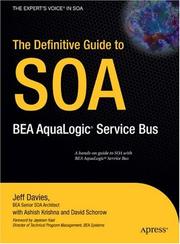| Listing 1 - 5 of 5 |
Sort by
|

ISBN: 1281116645 9786611116644 1430202637 1590597974 Year: 2007 Publisher: Berkeley, Calif. : Apress,
Abstract | Keywords | Export | Availability | Bookmark
 Loading...
Loading...Choose an application
- Reference Manager
- EndNote
- RefWorks (Direct export to RefWorks)
The Definitive Guide to SOA: BEA AquaLogic Service Bus targets professional software developers and architects who know enterprise development, but are new to enterprise service buses (ESBs) and service–oriented architecture (SOA) development. This is the first book to cover a practical approach to SOA using the BEA AquaLogic Service Bus tool. And it's straight from the “source”—BEA Systems AquaLogic product lead Jeff Davies. This book provides hands–on information to developing SOA–driven applications with ESBs as central components. It also gives strategic guidance on SOA planning, web service life–cycle management, administration of an ESB, and security considerations. Davies is careful to cut through theory and get straight to demonstrating successful use of the product where SOA really counts.
Electronic commerce --- Business enterprises --- Enterprise application integration (Computer systems) --- Computer programs. --- Data processing. --- WebSphere. --- Web sphere --- IBM WebSphere --- Application integration, Enterprise (Computer systems) --- EAI (Computer systems) --- Integration, Enterprise application (Computer systems) --- Application software --- Systems engineering --- Development --- Software engineering. --- Software Engineering/Programming and Operating Systems. --- Computer software engineering --- Engineering --- WebSphere
Digital
ISBN: 9781430202639 Year: 2007 Publisher: Berkeley, CA Apress, Inc
Abstract | Keywords | Export | Availability | Bookmark
 Loading...
Loading...Choose an application
- Reference Manager
- EndNote
- RefWorks (Direct export to RefWorks)
Programming --- Computer. Automation --- computerbesturingssystemen --- programmeren (informatica) --- programmeertalen
Book
ISBN: 9781430202639 Year: 2007 Publisher: Berkeley CA Apress
Abstract | Keywords | Export | Availability | Bookmark
 Loading...
Loading...Choose an application
- Reference Manager
- EndNote
- RefWorks (Direct export to RefWorks)
Enterprise Service Bus (ESB) is a hot topic today. Many vendors are either building new products in this category or dressing up their existing products to pitch them as an ESB. H- ever, there is no clearly accepted definition of what an ESB is, or what its architecture or programming paradigm should be. Definitions range from saying that ESB is wholly unneeded to saying it has all the capabilities of a full integration suite with built-in BPM, data aggre- tion, and WSM capabilities. Architectures range from being embedded in the clients and endpoints to being a central intermediary. Programming paradigms for the ESB range from writing Java to being completely configuration driven and pliable with graphical interfaces. BEA did not dress up one of their existing products and pitch it as an ESB but built an ESB from scratch. First introduced in summer 2005, BEA's ESB has a razor sharp focus on where it is positioned as a component in an end-to-end SOA architecture. It complements a BPM service or a data aggregation service but serves a different and distinct role. Much of SOA is about componentization, interconnectivity, and reuse, and the ESB component serves as an intermediary with the clear and distinct role of providing loose coupling between clients and services, a routing fabric, connectivity, and a central point of security enforcement that c- tribute to the manageability of your SOA network.
Programming --- Computer. Automation --- computerbesturingssystemen --- programmeren (informatica) --- programmeertalen
Digital
ISBN: 9781430210580 Year: 2008 Publisher: Berkeley, CA Apress
Abstract | Keywords | Export | Availability | Bookmark
 Loading...
Loading...Choose an application
- Reference Manager
- EndNote
- RefWorks (Direct export to RefWorks)
Book
ISBN: 9781430210580 Year: 2008 Publisher: Berkeley CA Apress
Abstract | Keywords | Export | Availability | Bookmark
 Loading...
Loading...Choose an application
- Reference Manager
- EndNote
- RefWorks (Direct export to RefWorks)
T he enterprise service bus (ESB) is a hot topic today. Many vendors are either building new products in this category or dressing up their existing products to pitch as ESBs. However, there is no clearly accepted definition of what an ESB is, what its architecture should be, or what its programming paradigm should be. Definitions range from saying that it is nothing and wholly unneeded to saying it is everything and has all the capabi- ties of a full integration suite with built-in orchestration, data aggregation, and web services management capabilities. Architectures range from being embedded in the clients and endpoints to being a central intermediary to being a decentralized intermediary. Progr- ming paradigms for the ESB range from writing Java to being completely configurati- driven and pliable with graphical interfaces. BEA Systems, the original creator of what is now the Oracle Service Bus, did not dress up one of its existing products and pitch it as an ESB. It built an ESB from scratch (first introduced in the summer of 2005), with a razor-sharp focus on where it is positioned as a component in an end-to-end service-oriented architecture (SOA). It complements a business process management or orchestration service, but serves a different and distinct role. Much of SOA is about componentization, interconnectivity, and reuse.
| Listing 1 - 5 of 5 |
Sort by
|

 Search
Search Feedback
Feedback About UniCat
About UniCat  Help
Help News
News